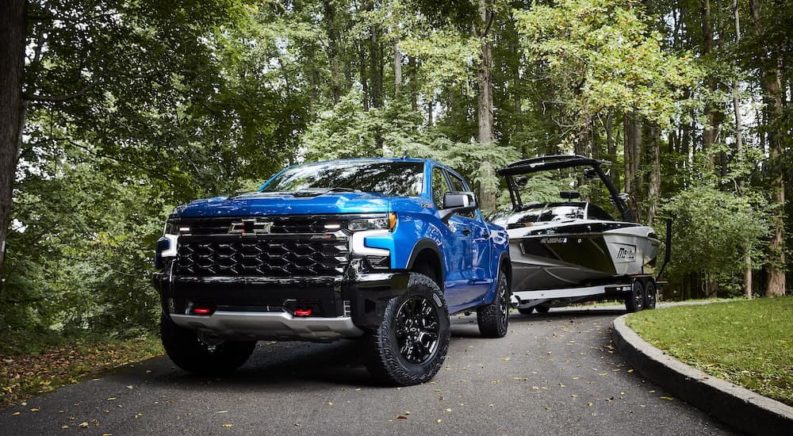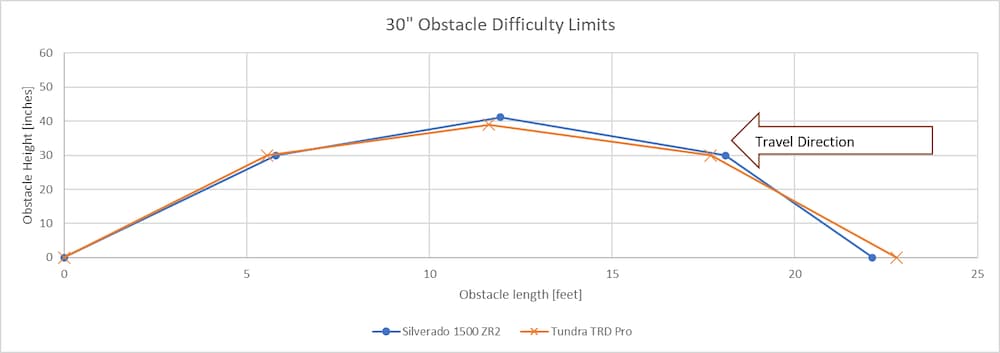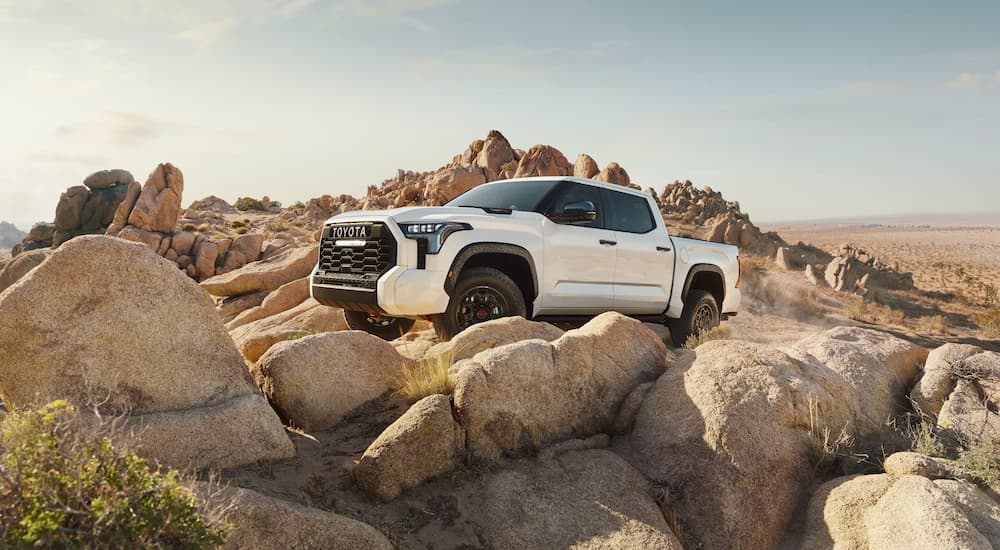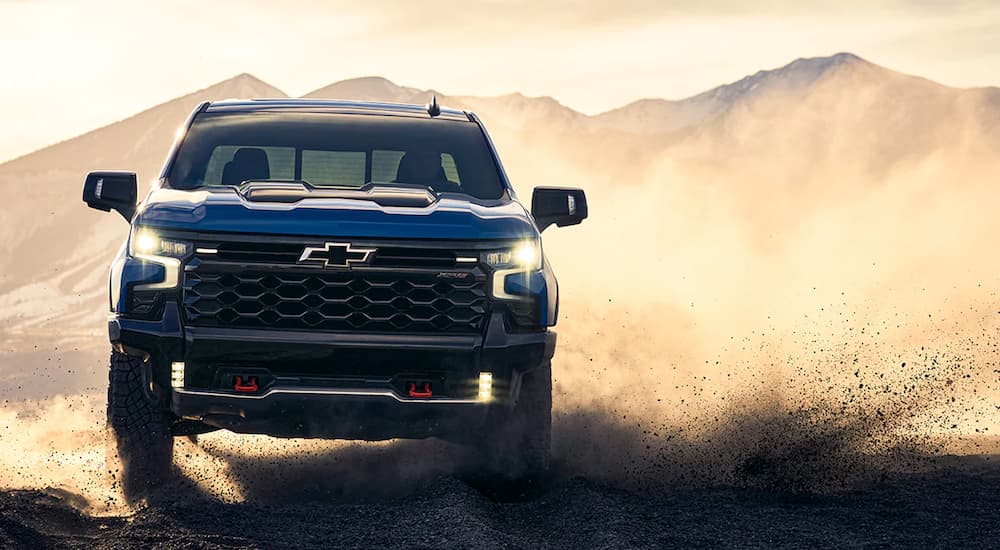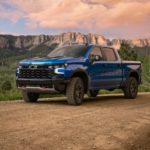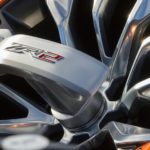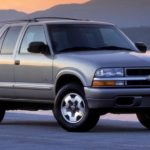Ahh, 2013. No war in Ukraine. No COVID. No fake news, no Brexit, we still had Kobe and Betty White, and I’m pretty sure Lance Armstrong was still cool, too, but don’t quote me on it. But you, dear reader, I know that you suffered. You adored Ford’s badass F-150 Raptor, then a 4-year-old model in its first generation, but whether you knew it or not, you suffered for the lack of competition. The Ford was out there, doing its thing all alone, with no meaningful competition to challenge it. It was Federer among prep schoolers, Tiger at minigolf, Gretzky in a Timbits League game, the Babe in Babe Ruth ball. Legendary, iconic, amazing––alone. You couldn’t have imagined that fewer than 10 years later, you’d be thinking about a showdown between off-road variants of the 2022 Chevy Silverado 1500 vs 2022 Toyota Tundra.
But you are! My, how times have changed! The off-roading full-size pickup truck segment, overly specific though it may be, has become crowded with serious entries from all major truck manufacturers (and some new ones!). The funny thing is that so few of them are genuine competitors––the performance metrics vary so widely that they spread out into several different tiers of performance and capability. The first-ever Silverado ZR2, for example, isn’t even close to being a Raptor-killer, and the TRX––which was designed to be exactly that––was so effective at the task that it created a whole new category and, rather than upgrade the truck they had, Ford just came up with a new one altogether!
But put the Silverado ZR2 next to the Tundra TRD Pro, and it is compelling. Representing the most off-roading capability offered by Chevy and Toyota in the full-size segment, the ZR2 and TRD Pro are more oriented towards regular truck stuff with a side of trail-busting instead of the other way around. So what’s the better truck? Is it the brand-new ZR2 trim of the heavily refreshed 2022 Silverado? Or is the designed, tested, and made-in-America 2022 Tundra, all-new and with years of TRD Pro experience behind it, still a step ahead of this newcomer to the off-roading scene?
Off-Roading: the Numbers Game
Even though both trucks are oriented towards regular truck stuff, if that was all I cared about, I’d look at any other trim level. I just can’t imagine a reason to care about the ZR2 and TRD Pro other than their off-roading capabilities, so even if they aren’t true Raptor killers, we’re going to start here––and like any good engineer, I’m doing it with a table:
Table 1 – Off-roading specs for 2022 models
| Parameter | Silverado 1500 ZR2 | Tundra TRD Pro |
|---|---|---|
| Approach angle [deg] | 31.8 | 26.2 |
| Breakover angle [deg] | 23.4 | 14.0* |
| Departure angle [deg] | 23.3 | 24.2 |
| Wheelbase [in] | 147.5 | 145.7 |
| Ground Clearance [in] | 11.2 | 9* |
*calculated from published wheelbase and ground clearance values
I will emphasize that I have been unable to locate a source for the TRD Pro’s breakover angle––I had to calculate it myself. Applying the same calculation to the ZR2 gives me a 17.5-degree breakover instead of 23.4, so…grain of salt, people. Either Chevy’s bad at math, or I am, and either way, Toyota ain’t talking.
Mysterious breakover angles aside, the ZR2 has a clear advantage. The approach angle is significantly better, and with removable bumper end caps, it’s designed to take abuse and break parts without breaking the bank. The ground clearance differential is also enormous (although it’d be a lot smaller if the unverified 10.9″ claim proves true) and contributes directly to a massive breakover angle gap (flawed though the numerical comparison above may be). Though Toyota has a slight advantage in departure angle and wheelbase, point to Chevy on this one.
What does that look like in real life? I’m glad you asked! The chart below imagines the most aggressive boulder-shaped obstacle each truck could tackle with 30″ ramp heights at either end. The length of each ramp is determined by the approach and departure angles, while the space in between is driven by wheelbase and the peak of the boulder depends on ground clearance (so the breakover angle controversy doesn’t contribute to the shapes). And though the Tundra’s minute departure advantage shows, it’s also clear that the Silverado ZR2 can handle bigger, more aggressive climbs––as long as it doesn’t need to come back down the same way.
Figure 1 – Illustrating the most aggressive boulder shapes the off-road trucks can handle
Off-Roading: the Kit List
Of course, geometry alone does not an off-roader make. I think the ZR2 is seriously ahead in the mechanical equipment it brings as well. While its 33″ Goodyear Wrangler Territory tires probably don’t do much more than Toyota’s 32.5″ Falken Wildpeak tires do, the real difference is in the shocks and differentials.
A nod to Toyota for dropping the leaf springs and using a multi-link coil spring rear suspension for 2022 to improve overall ride quality, and it must be said that the Silverado is still on leaf springs. But F1-developed Multimatic DSSV dampers give it the edge in suspension performance anyway, with three separate spool valves and three connected chambers providing some of the world’s best damper performance. The 2.5″ FOX shocks on the Tundra TRD Pro are excellent and possibly more rugged, especially with front and rear piggyback reservoirs to handle the most extreme impacts, but Multimatic’s revolutionary passive adaptive and position-sensitive damper tech provides an appropriate damping response in all scenarios without the added bulk or fragility of traditional adaptive systems, and with improved heat management characteristics for sustained performance. The 2022 Tundra has its own adaptive system, but not on the TRD Pro, so another point to Chevy.
Also, the Silverado ZR2 is coming out in 2022 with not one but two electronically controlled locking differentials, one for the front and one for the rear. Chevy is reportedly the first to offer front and rear lockers on a full-size pickup (although the Ram Powerwagon has had this feature for years), and Toyota is not yet the second, with only a rear locker on the features list. In case you didn’t already know, locking differentials are kind of important for keeping a nearly-three-ton rig moving when one wheel gets stuck in the mud (or is up in the air) while the other has grip. They make sure the wheel with grip keeps turning by preventing the free wheel from soaking up all the power. So when a TRD Pro is hanging a front wheel high, it might be SOL and calling a buddy in a Chevy for a hand.
I’ll drop in here that it looks like Chevy even offers a better transfer case. Toyota has a “4WDemand” part-time 4WD system which includes a two-speed transfer case and an automatic limited-slip differential, which I’d say is par for the course for an off-roader. Chevy’s AutoTrac transfer case offers a little bit more, with a 4WD Auto mode that will kick in when it senses wheel slip, acting like a typical AWD system for satisfactory handling in wet, wintry, or dirty conditions, as well as the typical 4HI and 4LO modes for actual off-roading.
Cruise Off-Road
And somehow that’s not all! Because off-road cruise control is now not only a thing but a cool thing that everyone needs to have (and let’s be honest, for what people pay to get these things, everyone should have), we need to take a look at it. Toyota and Chevy offer two very different systems here.
The TRD Pro gets CRAWL Control with five selectable cruising speeds so drivers can choose an appropriate crawl rate and focus on steering and braking as-needed. The Tundra also has Multi-Terrain Select (MTS) drive modes and Downhill Assist Control to limit speed during non-crawling descent scenarios. That’s a lot of helpful stuff!
The ZR2 offers something a little different. I don’t see a straight-up cruise control, so maybe that’s a knock against it to you, but I prefer the idea of Terrain Mode’s one-pedal driving rock crawling feature, keeping speed and braking under the driver’s control without having to move your foot in response to conditions. Chevy also has all the off-road drive modes and includes Hill Descent Control and Powertrain Grade Braking for maintaining safe speeds, though that last one seems more like a trailer control option. In any case, I’m liking the one-pedal driving, but I’d really have to try these all out to declare a winner.
The Other Stuff, I Guess
Is it hypocritical to focus so much on off-road features for these trucks and then evaluate how they do everything else? Maybe. But I also said that neither of these is a dedicated Baja runner like the Raptor––they’re normal trucks with great off-roading chops compared to their stock counterparts, so it isn’t fair to either vehicle to compare them on off-roading alone. To give these rigs a fair shake, then, I’m going to take a look at their powertrains and general usability features.
Powertrain Options
What matters more about a powertrain––what it is or what it does? I know a lot of people will take a 1970s V8 over a modern turbocharged 4-banger with three times the torque, power, and efficiency, but to me, it’s all about the results.
So, Chevy delivers the most powerful naturally aspirated V8 in the segment, with the 6.2L behemoth coming standard on all ZR2 models. If you like V8s, game over, end of story, the ZR2 is king, now you can leave. This engine’s 420 hp and 460 lb-ft of torque is fantastic, more than adequate for daily needs, and it has a classic ragged American V8 rumble to serenade us as it drives…to the next gas station because 15 MPG combined hasn’t been “good” for a truck since 2009. Likewise, the 8,900 lb towing limit and 1,440 lb payload cap are adequate for most truck users but won’t cut it for hauling large campers or boats on the regular.
Enter the TRD Pro. Sorry Chevy, but you’re just flat-out beat here. The Tundra TRD Pro gets the hybrid i-FORCE MAX powertrain, with a twin-turbo V6 and an in-line electric motor that combine for 437 hp and 583 lb-ft of torque. It lacks a V8 rumble, to be sure, but it also makes 21 MPG combined. And it handles more, too, with payload and towing limits of 1,600 lbs and 11,175 lbs, respectively. Big points to Toyota for sheer on-road performance limits.
Usability and Features
That being said, for loads within the limits of either truck’s capability, I’m going to suggest that it’s a little easier and more comfortable to get things done with the Chevy. Trailering technology and cargo management features are GM’s hallmark, and the ZR2 is no exception. Its 12 tie-down points, Corner Step rear bumper, and Multi-Flex tailgate simply outperform Toyota’s conventional bed design (which does include adjustable rail-mounted cleats and a power outlet)––not to mention Chevy’s segment-leading bed volume at 62.9 cu.ft. (Toyota’s is 46.5 cu.ft. at most, based on the dimensions). Chevy’s maximum 14 camera views, including Invisible Trailer, also leads the segment, and though Toyota’s tech is coming along, its 360 camera is still a long way from comfortable to use.
What’s more, are the creature comforts available in the ZR2. Sure, both trucks have heated and ventilated front seats, but Chevy’s are 10-way power-adjustable (Toyota’s are 8), and only Chevy brings a heated steering wheel. Both have keyless start, but only Chevy has remote start, and Toyota does not offer rain-sensing automatic windshield wipers on the TRD Pro. And can Toyota say that its advanced driver assistance features such as Blind Spot Monitoring can extend to trailers? I don’t think so, but Chevy’s Trailer Side Blind Zone Alert sure can.
All-New American Classics
At the end of the day, these are both excellent and expensive off-road-capable pickup trucks. It’s exciting to see both the 2022 Silverado 1500 ZR2 and 2022 Tundra TRD Pro burst onto the scene as new models, models which actually kind of make sense to own as daily drivers despite their advanced recreational capabilities. The TRD Pro delivers incredible power without totally breaking the bank and can out-haul the ZR2––but for daily use through the winter, for regular light truck activities and moderate off-roading, the Silverado is where it’s at. Just…maybe consider reversing over that boulder when you’re coming back down, alright?

